The magnificent Stupa at Bodnath near Kathmandu – the most vibrant & accessible Tibetan community in the world… ネパール、カトマンドゥー近郊のボダナートに建つネパール最大のストゥパ。ボダナートは世界有数のチベット文化の中心地として発展を続けるエネルギーに満ちた地だ
Bodnath – Kathmandu, Nepal
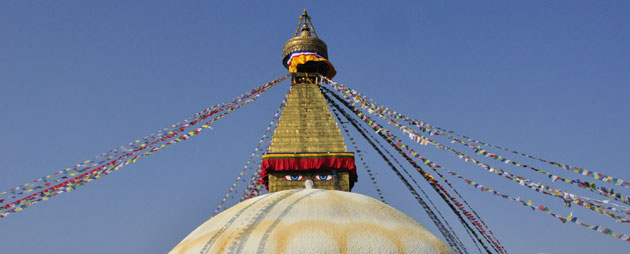

The magnificent Stupa at Bodnath near Kathmandu – the most vibrant & accessible Tibetan community in the world… ネパール、カトマンドゥー近郊のボダナートに建つネパール最大のストゥパ。ボダナートは世界有数のチベット文化の中心地として発展を続けるエネルギーに満ちた地だ
![Touring Laos After the excitement and surprise of Myanmar, Laos turned out to be a totally different adventure again. From Bangkok, we caught the overnight sleeper train […]](http://meltingplots.com/wp-content/uploads/2009/10/Hmong_Chillis.jpg)
After the excitement and surprise of Myanmar, Laos turned out to be a totally different adventure again. From Bangkok, we caught the overnight sleeper train to ChangMai in Northern Thailand, a pleasant slow paced 12 hour journey that reinforced many of the aspects of travel that you miss when simply jumping on an plane. I had been reading a fantastic book by Tiziano Terzani called “ A Fortune-Teller Told Me”, which narrates the tales of a year spent traveling around Asia by land and boat (after a fortune teller told him he would die if he caught a plane) and his subsequent embrace of time, mystics, distance and the experience. Sitting on that overnight train and later on a 2 day boat trip down the Meekong, these ideas resonated strongly within me. Somehow watching the cities slowly give way to villages and the farms, fields and rice paddies fading into mountains is immensely satisfying. You absorb these transitions to the rhythms of the journey without thinking, your subconscious celebrating the minor changes. Reaching a destination has such a greater sense of expectation and arrival that way.
After a few days enjoying the relaxed city, food and magnificent markets of Chang-Mai we then took a minivan to the Thai border with other like minded traveling brethren. From that moment to crossing the Laos border at Houei Xay (via boat over the Mekong River) until reaching Vientiane and heading back into Thailand, Laos felt like a strange, alternative travel, SE Asia backpacking theme ride. We seemed to follow a route so defined by Lonely Planet and others as the “backpacker adventure trail”, that we rarely felt we had an original experience, even when out “trekking” amongst the Hill Tribes or kayaking down a river. Thankfully though, it was not Contiki or P&O and we had a great time doing it and of course there were several fantastic exceptions.
From the border, we took the 2 day slow boat down the Mekong, stopping for the night in Pak Beng before arriving at Luang Prabang. We had heard conflicting tales alternating between the glowing and the horrific about this trip (mostly referencing the wooden seats, nightmare accomodations & drunken revelry), but actually found the experience to be a lot of fun. Packed onto a large boat with about 70 other like minded souls, the Mekong banks, eddies, fishermen and occasional village flow by at a steady, almost dreamlike pace. You have little else to do but read or interact with fellow passengers. (Typically an interaction that becomes more boisterous towards the end of the day, as the beer flows more freely). One tip if you do ever take the slow boat though – its definitely worth making the effort to be at very least friendly to the other travelers; we spent the rest of our time in Laos crossing paths – sharing tours, restaurants and transport with them.
Arriving in Luang Prabang, we shored up in a cheap guesthouse room, just back from the old city centre. Luang Prabang is a wonderful city, sitting at the junction of two rivers it is the ancient capital of Laos, home to its former kings and royalty. As a result, the place teems with temples, style and good food and is so unexpectedly civilized, orderly and relaxed for South East Asia, that it would be more at home in Europe, made more pronounced by the distinct french influence on the food and architecture. Several days flew by simply soaking up the markets and many shops showcasing wares of the Hill Tribes, cycling around the town and trialing the wonderful delights of the Laotian cuisine. We also did a single day trek out through a Hmong village, some jungle and a spectacular waterfall before moving on with some regret.
Reluctantly dragging ourselves away, we endured the nightmarish, 7 hour bus trip along the treacherous winding roads to the bizarre tourist oddity that is Vang Vieng. Set on a river, with a spectacular backdrop of limestone cliffs and caves, Vang Vieng is a once beautiful undiscovered village oasis, evolved into a tubing and adventure sports wonderland. Full of cheap, garish guesthouses and bars – it attracts with the triumvirate of traveller offerings – low cost, parties and adventure. Not that we were any different mind, all across Asia you will see people wearing singlets with the logo “In the Tubing, Vang Vieng”, equally you will hear tales of ‘tubing’ as being the most fun to be had in Asia. Big claims and despite our reservations and initial horror at the circus we were now joining, we found a somewhat secluded guesthouse with a view and signed up for the ride.
Tubing refers to a big day out on the Nam Son river. You rent a tractor tire tube in town and jump in a mini truck for a lift up to the river. Once there you jump into your tube and float down the river to one of the 20 or 30 bars that dot the shore especially for this purpose – each with its own range of activities, swings, drink specials, shots and “mystery” shakes. The goal is really to get back before 6pm or lose some of your deposit on the tube. Tacky perhaps, but without doubt a lot of fun, if not simply because its something you just don’t get to do anywhere else!
After couple of days of this, we decided to Kayak our way to Vientianne, a pleasant outdoorsy break from the constraints of bus travel. Vientianne though was really very simply about the food – we spent a couple of days working through the menus at some nice Laos and fusion restaurants – incredibly cheap for the quality. While most of the Lao food was great, I can especially recommend the Lao salads (Laap) – vegetables and / or meat minced together with mint and other herbs, highly addictive and refreshing and goes perfectly with Lao beer which was also very good.
All told, with more time and flexibility we would have loved to get off the track and probe Laos further, especially in the far North where the hill tribes and mountains remain largely untouched. While our trip felt quite shepherded it did not really detract from the experience, the people are friendly & relaxed; beautiful vistas and the food fantastic. Very hard to complain, but we were quite happy to move onto the real travelling.
Recommended Reading:

Sunset over Vang Vieng – after a day floating wasted down the river in tire tubes. Simply fantastic!
ラオス・バンビエンで一番人気のアクティビティ、タイヤチューブに乗っての川下りで童心に返ったあとにバーの垣根越しに見た夕焼け
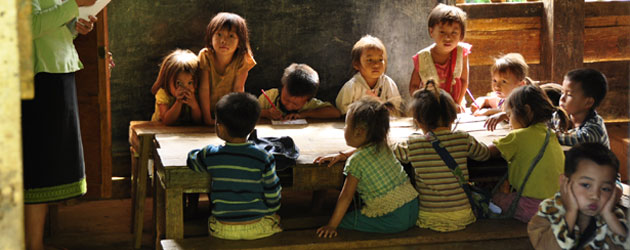
Kids attending a school in a small Hmong hill tribe village in Northern Laos. ラオス北部の山岳民族、ハモンの子供たち。そっとのぞいた小学校の質素な教室は子供たちのにぎやかな声でいっぱい
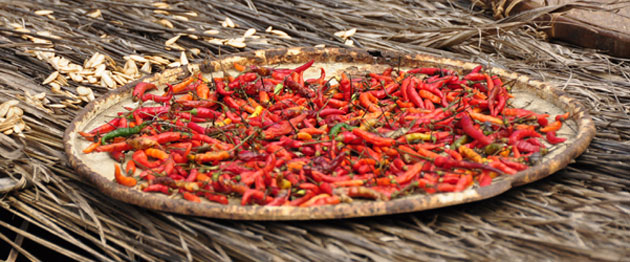
Chilli’s drying on the roof of a hut in a Hmong (Hill Tribe) village ラオス北部に住む山岳民族、ハモンの村で、屋根の上に干されていた真っ赤な唐辛子を見つけた
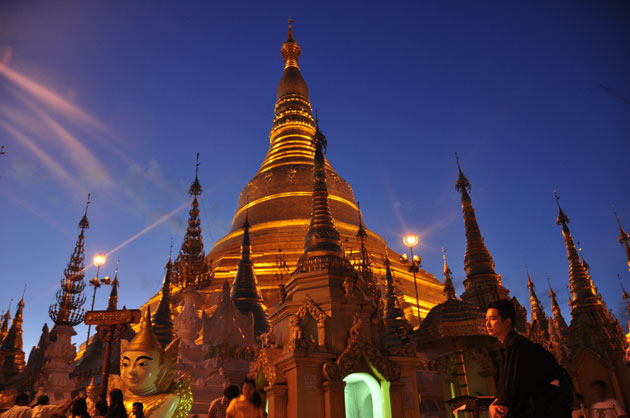
Wow – its not often you go somewhere and are completely taken by surprise.
I found Myanmar to be amazing for a whole raft of reasons; reconnecting with an old friend; beautiful & friendly people; totally unexpected (and photogenic) sights and most significantly I think – the fact that it just seemed to operate as a wonderful time capsule of Asia as it used to be, a romantic Asia – untouched by the desperate race towards modernity that now seems to pervade Asia everywhere today.
It was an experience perhaps also made more magical by the impromptu and spontaneous nature of it. On a whim, we thought we would go simply because an old friend, an ex-girlfriend of mine, Selena, was working for an NGO (CARE Australia) there. It was a nice reminder that not knowing a place is often where the real magic occurs, no plans, no research – just genuinely being open & surprised by what’s put it front of you. All of which is heightened considerably when someone also tells you that you are not allowed to go either.
Myanmar (or Burma as it used to be called) has largely been cut-off from the outside world since a revolution in the 60’s & the resultant ruling military class decided to combat capitalism, by closing off the Burmese culture from the rest of the world. A hibernation of sorts that took a significant turn for the worse in the 90’s, when the next generation of generals purged their democratic opponents and most famously put Aung San Suu Kyi under house arrest. Since then – not many people go in or leave really, most international companies have trade embargos in place and Myanmar as its now called, operates in almost isolation. Many things we read, said not to go (thereby financing and supporting the regime), but the people we met and talked to provided a different perspective – they want the interaction and by not staying at major hotels or doing organized tours, you do put money in the pockets of real Myanmar people. I couldn’t be more glad that we went and it felt like we only scratched the surface. We left promising to return.
But back to the trip itself! After arriving inYangon, we spent several days at Selena’s place, an old colonial building in the ‘rich’ part of town where we were spoilt by maids, gardeners, language teachers and Sel’s many other Burmese friends who took it upon themselves to cook for and engage with us. An experience perhaps sadly shaped (though certainly made more intimate) by the unfortunate death of Selena’s pet cat, Samadhi. That aside, with a comfortable Yangon base, we were able to relax and explore the cities atmosphere, markets, backstreets and almighty Shwedagon in complete comfort.
Reluctantly, we did manage to pull ourselves away for a few days. Flying first to Bagan and then onto Inle Lake for further exploration. All said we only spent 10 days in the country, simply not enough time to really do justice to the Myanmar that we encountered. Truth be told, it was a little expensive in parts, mostly the fault of a tightly packed itinerary that forced us into taking planes when boats, trains and other transport would have evoked infinitely more memories. More significnatly though it was a strong lesson for our future travel endeavours and we left with firm promises never to allocate less then 2 weeks to any country for the remainder of our trip.
Anyway, the whole experience as usual is hard to distill into words, so my apologies if I jump into bullet point highlights and let photo’s do the talking. We took thousands of great photo’ s for exactly that and I have outlined some of the key highlights below:
Some Myanmar reading recommendations:
Photo Exerpts from Myanmar:
(Have shared many more on Facebook)
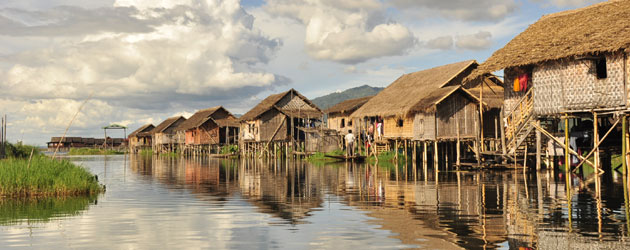
Some of the many thousands of houses, villages, monasteries and farms that exist on Lake Inle.
ミャンマー・シャン州のインレー湖では、水上に家々や集落、寺院が浮かび、水栽培のトマト畑が広がる。
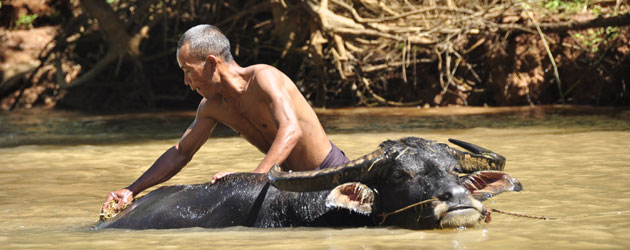
Just about everything happens in the water, around the Inle Lake region..
ミャンマー・インレー湖から伸びる水路で水浴びする水牛。ここでは生活のすべてが水と共にある。

A small representation of some of the 4,000 ancient (1,000-1,200 AD) ruins that permeate the Bagan plain…
11-13世紀にミャンマーの都として栄え、世界3大仏教遺跡のひとつに数えられるミャンマー・バガン遺跡。赤土の平原に約4000の遺跡が点々と散らばる。